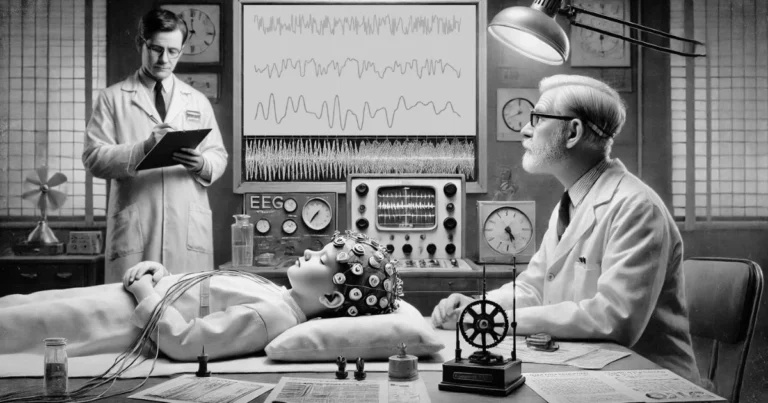Beyond words: can we think without words?
We often assume that thinking means talking to ourselves silently. But is that truly the case?
Imagine a world without words. Could we still reason, anticipate, and solve problems? Some argue that without language, complex thought would be impossible, that our ideas would be limited to vague sensations and blurred images.
However, both scientific evidence and personal accounts challenge this view. People born deaf who have never learned a formal language still develop sophisticated thought processes. Infants engage in problem-solving before they can speak. Even Einstein claimed he thought in images rather than in words. So, is language merely a communication tool, or is it the very architect of our thinking? Can we truly conceive without words? Let’s explore this fascinating cognitive puzzle.
Language and thought: A philosophical and historical inquiry
For centuries, philosophers and linguists have debated the connection between language and thought. Is language just a tool for expressing pre-existing ideas, or does it shape the very structure of our thinking?
Plato believed that ideas exist independently of language in a realm of forms accessible through reason. Aristotle, in a more pragmatic approach, viewed language as a natural means to express thought, but not its foundation.
In the 17th century, Descartes reinforced this view, asserting that thought is a property of the soul, with language merely revealing it. In contrast, Hobbes and Locke argued that words shape our ideas, assigning language a central role in the structure of reasoning.
In the 19th century, linguistics took center stage. Wilhelm von Humboldt proposed that each language crafts a unique worldview. Edward Sapir and Benjamin Whorf later expanded on this idea, suggesting that language structure influences thought and perception, a theory known as linguistic relativity.
Ferdinand de saussure: Language as the framework of thought
At the turn of the 20th century, Ferdinand de Saussure revolutionized linguistics by introducing the concept of the linguistic sign, composed of two inseparable parts:
- The signifier (the sound or written word)
- The signified (the mental concept it evokes)
This relationship is arbitrary and defined by social conventions within a linguistic community.
According to Saussure, raw thought is a chaotic, unstructured mass. It is only through language that thought becomes organized and intelligible. Language does not simply label ideas, it segments, shapes, and structures them. In this way, language imposes a cognitive framework that influences our perception of reality.
For instance, some languages categorize colors differently, which affects how speakers perceive them. Others grammatically encode concepts like time or gender, subtly guiding thought patterns.
Jacques Lacan: Language precedes the subject
Saussure’s influence is evident in Jacques Lacan’s psychoanalytic theory. Lacan pushed further, asserting that language not only structures thought, it precedes the subject entirely.
In his view, individuals become thinking beings only by entering the Symbolic Order: the structured system of language, laws, and social norms through which meaning is constructed. Learning to speak is not just naming things, it is a psychic inscription, a way of organizing one’s relationship to self and others.
Lacan also emphasized the Imaginary, another register central to subject formation. His famous “mirror stage” illustrates this: before they can speak, children recognize themselves in a mirror, forming an idealized self-image. Yet this image is deceptive, a construct that only gains meaning through language and social validation.
Then there’s the Real, what resists symbolization. This register represents the unspeakable, the ungraspable elements of experience that often return as trauma or anxiety. Language structures thought, but it cannot fully capture all dimensions of human experience.
For Lacan, consciousness, the unconscious, and the sense of self are structured like a language. Thought is embedded in the Symbolic, shaped by the Imaginary, and confronted by the Real. Language, then, is not merely expressive, it is a precondition for thought and subjectivity. Can we really think without it?
Noam Chomsky and the language-thought divide
Noam Chomsky, a key figure in 20th-century linguistics, offers a different take. Unlike relativist theories such as Sapir-Whorf’s, Chomsky contends that while language and thought are connected, thought can exist independently of spoken language.
Chomsky is best known for his theory of generative grammar. He proposed that humans are born with an innate language acquisition device (LAD), enabling them to learn any language from limited input.
For Chomsky, language is a unique cognitive system, but not the only form of thought. He distinguishes between:
- Deep, abstract thought, which may exist without verbal language
- Language as expression, which translates these thoughts into words but does not create them
In an interview, he stated, “One can certainly think without language. Thought is much broader than language. There’s a lot we simply can’t express in words.”
Chomsky aligns with rationalist thinkers like Descartes, maintaining that thought can exist independently of linguistic expression. He sees language as a facilitator, not the sole determinant, of human cognition.
In this view, humans possess abstract cognitive structures that operate beyond words. Language enhances and refines thought, but it is not the origin of it.
Two contrasting paradigms
This ongoing debate reflects two dominant paradigms:
- The Rationalist-Essentialist Tradition (Plato, Descartes, Chomsky): Thought precedes language, which is merely a tool for its expression.
- The Structuralist-Linguistic Tradition (Saussure, Lacan, Whorf): Language structures thought and perception, shaping how we experience reality.
This dichotomy lies at the heart of modern cognitive science: can thought truly occur without language, or is all thinking inherently linguistic, even if unconsciously?
Thinking Without Words: A Cognitive Reality?
Language is often viewed as essential to thought. Still, several forms of reasoning appear to operate without it.
Visual thinking and mental imagery
Some individuals report thinking primarily in images. Temple Grandin, an autistic animal behaviorist, describes her mind as a series of detailed mental films. She doesn’t use verbal reasoning, instead, she manipulates visual representations to solve problems. Albert Einstein similarly noted that his scientific insights emerged from visual thought experiments before being translated into equations or words. These accounts suggest that nonverbal cognitive processes are not only possible but highly effective.
Preverbal thought in infants
Recent research shows that infants exhibit complex cognition before acquiring language. For instance, Monica Barbir and colleagues at the Cognitive and Psycholinguistic Sciences Lab (LSCP) found that 20-month-old babies can learn grammatical rules within minutes and use them to acquire new vocabulary, indicating early reasoning abilities independent of verbal language.
These findings support the idea that preverbal thought plays a crucial role in cognitive development, allowing infants to analyze and interpret patterns before they can speak.
Aphasia and non-linguistic reasoning
Studies on aphasia (language impairment due to brain injury or stroke) reveal that even when language comprehension or production is severely disrupted, reasoning may remain intact.
In one study, aphasic patients were given tasks requiring no verbal response:
- Visual reasoning puzzles
- Image-based pattern recognition
- Sequencing actions using picture cards (e.g., making coffee)
Many patients performed on par with non-aphasic individuals, demonstrating that reasoning, memory, and logic can function without access to language. These results challenge the assumption that language is necessary for thought.
Thought without formal language: The case of deaf “home signers”
Some people born deaf develop their own gestural systems, known as “home sign”, without exposure to formal sign language. These self-created systems offer a unique insight into thought without formal linguistic structure.
Despite lacking formal grammar, home signers invent consistent gestures to convey abstract ideas, actions, and spatial relations. Research shows these systems follow predictable rules, enabling meaningful communication.
Even without conventional syntax, home signers demonstrate:
- Action planning and problem-solving
- Emotional and intentional expression
- Abstract reasoning, including concepts like time and causality
Nevertheless, these gestural systems may have limitations. Without full grammatical structure, expressing complex ideas becomes more difficult. This suggests that while thought can exist without language, linguistic systems enhance and refine it.
Does language still shape thought?
Despite compelling evidence for nonverbal cognition, many researchers argue that language fundamentally shapes how we think, even when we’re unaware of it.
- Words organize thought: We may perceive something without naming it, but memory and reasoning often transform it into verbal form.
- Inner speech: Most adults engage in ongoing inner dialogue, using language to structure their thoughts.
- Memory studies: People remember things better when they can name them, suggesting language aids memory and abstraction.
Moreover, some perception errors seem language-based. For example, when people lack a word for a color or shade, they struggle to distinguish it, supporting the view that language influences both cognition and perception.
While nonverbal thought exists, it appears limited in its ability to handle abstraction. Language allows us to conceptualize complexity, structure logic, and communicate nuanced ideas. Instead of opposing views, we might consider that thought is hybrid: some reasoning arises without words, but language remains a powerful tool that amplifies and refines cognition.
Silent minds: What monks reveal about thought without words
Advanced meditators offer a striking example of nonverbal awareness. In deep meditative states, Tibetan Buddhist monks describe vivid, lucid consciousness entirely dissociated from internal speech. These are not just silent minds but heightened states of awareness rich with insights, feelings, and mental clarity.
Neuroscientific studies support these claims. Research led by Richard Davidson at the University of Wisconsin showed that monks with over 10,000 hours of meditation displayed:
- Elevated gamma wave activity (linked to high-level cognition and consciousness)
- Increased prefrontal activation (associated with positive emotion and well-being)
- Decreased activity in language and spatial orientation areas
These findings indicate that during deep meditation, the brain can sustain active cognition without linguistic input. This challenges the notion that abstract reasoning always requires language.
Cognitive psychology and neuroscience reveal that some functions, like logic or categorization, are enhanced by language, while others, such as perception, intuition, and emotion, may operate independently.
Rather than being a prerequisite for thought, language likely acts as a cognitive amplifier, structuring, organizing, and transmitting ideas that can also emerge through nonverbal means.
Language undoubtedly shapes how we think, but it is not the sole engine of thought. It structures, sharpens, and communicates our ideas, but it doesn’t monopolize reasoning. From visual thinking and sudden intuitions to raw emotion and silent decision-making, the human mind traverses realms beyond words. Whether in babies, aphasics, meditators, or animals, cognition clearly exists outside linguistic boundaries. We can think without words. But such thinking may follow a different path, less linear, more diffuse, yet no less real.
References
Barbir, M., Babineau, M. J., Fiévet, A.-C., & Christophe, A. (2023). Rapid infant learning of syntactic-semantic links. Proceedings of the National Academy of Sciences, 120(1), e2209153119.
Chomsky, N. (1957). Syntactic Structures. The Hague: Mouton.
Grandin, T. (2006). Thinking in Pictures: My Life with Autism (Expanded ed.). New York, NY: Vintage Books.
Locke, J. (1690). An Essay Concerning Human Understanding. London: Thomas Bassett.
Lutz, A., Brefczynski-Lewis, J., Johnstone, T., & Davidson, R. J. (2008). Regulation of the Neural Circuitry of Emotion by Compassion Meditation: Effects of Meditative Expertise. PLoS ONE, 3(3),e1897.
Piaget, J. (1923). Le langage et la pensée chez l’enfant [The Language and Thought of the Child]. Neuchâtel: Delachaux et Niestlé.
Porch, B. E. (1973). Porch Index of Communicative Ability. Palo Alto, CA: Consulting Psychologists Press.
Saussure, F. de. (1916). Cours de linguistique générale [Course in General Linguistics]. Lausanne: Payot.
Vygotsky, L. S. (1934). Myshlenie i rech’ [Thought and Language]. Moscow: Gosudarstvennoe social’no-ekonomičeskoe izdatel’stvo.
Whorf, B. L. (1956). Language, Thought, and Reality: Selected Writings of Benjamin Lee Whorf. J. B. Carroll (Ed.). Cambridge, MA: MIT Press.

Amine Lahhab
Television Director
Master’s Degree in Directing, École Supérieure de l’Audiovisuel (ESAV), University of Toulouse
Bachelor’s Degree in History, Hassan II University, Casablanca
DEUG in Philosophy, Hassan II University, Casablanca







